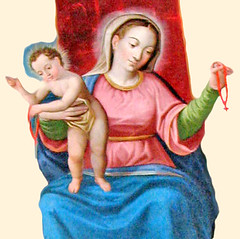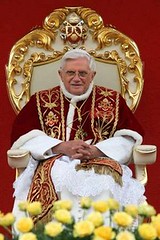The Fruitfulness of the Cross
 Station at Saint Cyriacus'
Station at Saint Cyriacus'The Church today unites the memory of a martyr with that of the Passion of Christ, the King of Martyrs, by making the Station in this church built in honour of the holy Roman deacon Cyriacus who received the palm of victory under the Diocletian persecution. However this ancient parish church of Rome was destroyed and the Station was transferred to the church of Santa Maria in Via Lata which itself dates to the 5th century and where the head of St Cyriacus is now enshrined. As legend has it, this church St Mary on the at the Via Lata stands on the site where Ss Peter and Paul and the evangelists Luke and John stayed when they were in Rome. Notably, one tradition has it that St Paul was under house arrest on this site as he awaited trial, which would lead to his eventual martyrdom.
Today's Gospel speaks of the Son of Man who is lifted up (Jn 8:21-30) just as the bronze serpent was lifted up in the desert (Num 21:4-9). At an earlier point in St John's Gospel, the Lord directly tells Nicodemus that "Just as Moses lifted up the serpent in the desert, so must the Son of Man be lifted up, so that everyone who believes in Him may have eternal life" (3:14). In the Jewish interpretation of the text from Numbers, the fact that Moses was told to not just fashion the bronze serpent but to place it on a pole is significant. The Hebrew word used here for 'pole' was sometimes used elsewhere for the word 'sign'. As such, Philo says that "through beholding this, [the Jews] behold God Himself". As such, looking at the serpent was not to acknowledge some hidden power in the thing created but to acknowledge the power of God to save. Thus one rabbinical interpretation says: "When Moses did so, the Israelites looked at it and put their trust in Him who ordered Moses to do so; then God would send them healing." Clearly then, when Jesus associates Himself with the bronze serpent that is lifted up, He is saying that He is the sign of salvation; indeed, his very name means 'God saves'. Thus, in today's Gospel he makes this even more explicit when he says, "When you lift up the Son of Man, then you will realize that I AM..." (Jn 8:28), saying in effect that He is God Himself.
 The serpent on the pole is the foreshadowing of that great sign of salvation, the Cross, which is the focus of this Passiontide. As we will sing on Good Friday: "This is the wood of the Cross, on which our Redeemer hung." The Cross is the wonderful sign of our redemption, which is why it is hailed in our Passiontide hymn, the Vexilla regis:
The serpent on the pole is the foreshadowing of that great sign of salvation, the Cross, which is the focus of this Passiontide. As we will sing on Good Friday: "This is the wood of the Cross, on which our Redeemer hung." The Cross is the wonderful sign of our redemption, which is why it is hailed in our Passiontide hymn, the Vexilla regis:"O Tree of beauty, Tree of light,
O Tree with royal purple dight;
Elect, on whose triumphal breast
Those holy limbs should find their rest;
On whose dear arms, so widely flung,
The weight of this world's ransom hung
The price of humankind to pay
And spoil the spoiler of his prey."
As the Tree of Life, the Cross, bears Christ who is the "first fruits from the dead", so too the Holy Cross also has an eternal fruitfulness in those who follow Christ's way of self-giving love, especially in the martyrs and saints. Hans Urs von Balthasar says:
"It is precisely through his obedience that the love of the Son for the Father is to become visible for the world, and this law - obedience as the sole and sufficient prove of love - is continually impressed on the disciples. Thereby, the sphere of the Father's sovereignty over Jesus is broadened out into the world, and this broadening - finally to be universal - is the goal of Jesus' work of obedience. This means that it is 'fruitful' in accordance with its own innermost law. As the act of love, Jesus' obedience is anything but 'passive'; his making way for the Father's will is not merely temporarily a joint act with the Father (in the proclamation and the working of miracles), but remains active even during the Passion, in that he 'draws everything to himself' on the Cross and 'gathers it'; indeed, only on the Cross does he truly begin to produce fruit beyond himself, in those who are his, who are his 'branches'..."
Let this also be our prayer and our hope and by the intercession and example of St Cyriacus and the holy martyrs may we too be fruitful in Christ, ourselves given to the Father's will in love and obedience.







0 Comments:
Post a Comment
<< Home